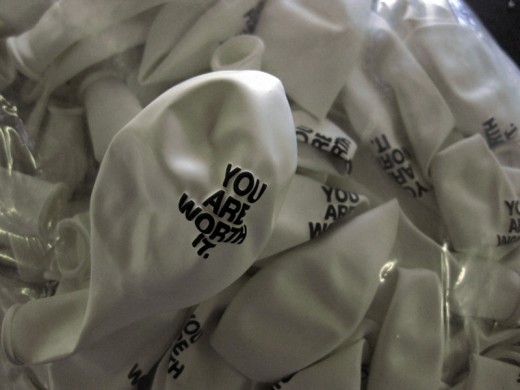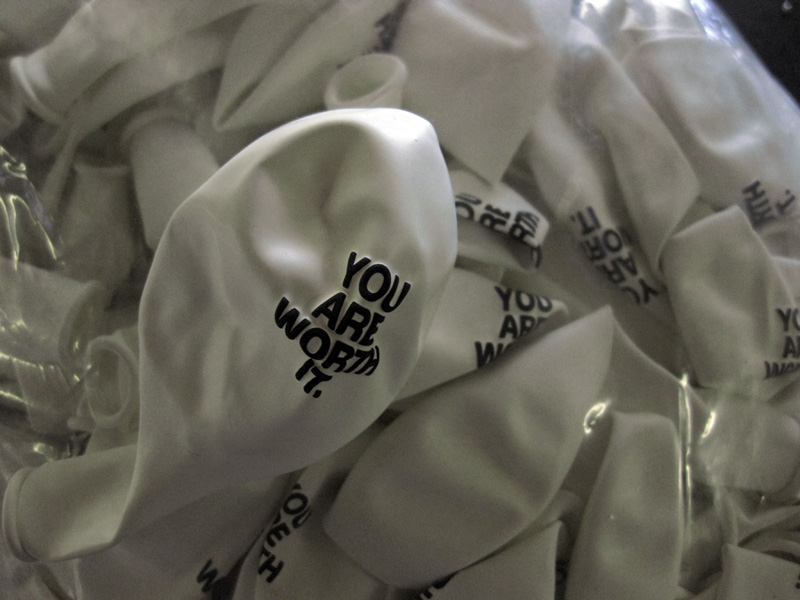
As part of Green Corridor’s Open Corridor festival, I’ll be working with 500 biodegradable balloons with “YOU ARE WORTH IT.” printed on them. The balloons will be filled with helium and some wildflower seeds, 200 of them will be launched anchored throughout the Green Corridor area and handed out to those in attendance next Thursday, June 18th.
Over the next few months, the remaining 300 balloons will be used for a variety of smaller launches and handed out in small bunches.
The balloons will act as a kind of seed bomb, meant to distribute wildflowers to some of the many ideal locations across the city for new gardens.

What are these made of? Are they more expensive than regular balloons?
I ordered these from Toronto, where they did the printing, I think it worked out to be around $0.50 / balloon, but not sure how much more expensive that would be than regular balloons. The balloons are made from natural latex and are supposed to break down at the same rate as a leaf off a tree.
This still seems more pointless than the planters. Just because their biodegradable, animals could still eat the balloons and die in the meantime. It seems like a backwards way to plant seeds.
From the research I did, I understood that latex helium inflated balloons reach a certain height, freeze and then basically explode into many tiny, tiny pieces, rendering them harmless to wildlife. Mylar balloons and balloons with strings or weights tied to them and released, however, are extremely harmful.
The idea is still evolving, and it may be more interesting to hand out the 200 than to just release them, or find compelling places to weight them or tie them… still a few more days to think about it.
http://www.gazettelive.co.uk/news/the-environment/green-bits/2006/08/23/balloons-kill-wildlife-84229-17645092/
I don’t think these will reach the upper atmosphere, freeze and explode. I’ve seen weather balloons do this but they are very large in order to have enough helium to carry them that high.
Tiny pieces are what kill wildlife.
You also said “The balloons will act as a kind of seed bomb, meant to distribute wildflowers to some of the many ideal locations across the city for new gardens.”
How are you supposed to control where the seeds land when they are miles up in the sky?
From the research I found, it indicated that latex balloons react as I mentioned before. However, concerns about the effects of balloons on wildlife are certainly something I’m going to take into consideration, and as I also mentioned before, the idea is still evolving and it may not result with any significant number of balloons being released. As for the seeds and their dispersal, I view the many possible iterations of this project as suggestions for ways of thinking about seed bombing (not that all suggestions have to work, or by that definition, succeed) and for ways of interacting with the urban environment. Ultimately, I very much enjoy the possibility of the balloons being part of an exchange, with the message on the balloons impacting the experience of that exchange.
http://www.longwood.edu/CLEANVA/balloons.htm
I still think it’s littering. Some states even Virginia have made releasing balloons against the law.
Sorry to go on and on.
Buyer beware here. Someone selling you a “biodegradable” balloon may not have your best interests at heart. The standard latex balloon biodegrades at the same rate as an oak leaf. The Balloon Council states: “Research shows that regardless of the latex balloon’s ultimate form when it lands, it will decompose, forming a natural soil nutrient at the same rate as that of an oak leaf.” See the entire article at http://www.balloonhq.com/BalloonCouncil/facts.html#litter.
As far as price, I’m not sure what size balloon you used, but a search at http://www.TMyers.com shows that a 100-count bag of Qualatex 11-inch round balloons sells for an average of $12. That’s 12 cents each, and that’s not a wholesale site. A search for custom printed Qualatex balloons reveals 500 12-inch printed balloons, one-side, for 34 cents each. If you printed both sides, the 50 cent price would make sense.
Your idea is inspiring, especially the wildflower seed idea! To make sure this stays a green project, when you give out the extra 300 balloons, you will want to make any string that is attached to the balloon biodegradable as well.
I love that the main product I work with is so green, even down to the way it’s harvested (see more at the Balloon Council’s website). And it’s fun, too!
Have a great time on the 18th! I’d love to hear how this project turns out.
Annie Banannie, Balloon Storyteller
Because Every Balloon Has a Story . . .
The balloons I got for the project were Qualatex from Stitchy Lizard in Toronto, and yes good call, I was thinking about using hemp for the strings when I give them out to ensure it was biodegradable too.
what time are you doing this balloon thing on thursday, and where? i just realized it’s the same day as CNAP, and that is at 6:30pm.
also, i really like the idea of weighing them down in certain places and leaving them there.
The entire opening for Open Corridor is on Thursday starting at 3pm. There will be a guided tour of all the works followed by a reception at 4:30pm. This all takes place at the Lebel building. Hope you can make it Samantha.
Yes, I think I already have some places in mind for where I could possibly place some with weights, including on the berm, where the seeds will have better a chance to germinate. Also, if you come, you will be more than welcome to take some inflated balloons with you!
oooh that’s a perfect time. i hope i can make it in time.
i totally will take a few : ) i was just thinking how it would be neat to weigh some down in the tall grasses on medians.
Can’t wait to see everything put together for the Open Corridor on Thursday. I’ve been driving by every so often, watching some of the installations going up. I like that solar powered watering can.
One thing that I wonder about though, with respect to the balloons, how fast do they degrade? I just wonder where they’ll end up come Thursday night/Friday morning, and how soon they’ll decompose… hopefully not affecting wildlife.
There are a couple Canadian links to the concern about animals seeing the balloons as prey, and ingesting them. But these natural balloons are ok, right?
http://www.mcsuk.org/downloads/balloons/factsheet.pdf
http://www.hww.ca/hww2.asp?id=173
As I understand it, the balloons degrade at the same rate as an oak leaf. Having given it some thought and certainly through engaging in this conversation, my plan will be to forego any mass release of the balloons. Instead I’ll be anchoring a small number of them in the Green Corridor area and giving them out to people and requesting that they not release them into the air. I much prefer it to be a positive gesture.
I’m glad to hear this justin since I’ve contacted ERCA and Erie Wildlife Rescue about this mass release. It’s seem hypocritical for a group who is so green to be doing this which can cause so much harm.
Have you walked in the woods often to see how quickly a oak leaf breaks down? I walk in Ojibway all the time and I still see oak leaves from years past on the ground. So these balloons do not break down over night. Even if you use hemp strings, it will still cause harm. If a state thinks highly enough of this to ban the mass release of balloons, I hope that at least can convince you that this is wrong to do.
I hope you will just hand out seeds send the balloons back. It’s better our environment is without them wasting away. You will be doing a service to the wildlife.
You can even see in this study, an oak leaf was picked for it’s slow decomposing properties:
“Yellow poplar (Liriodendron tulipifera)
was chosen as the fast decomposing leaf type and
white oak (Quercus alba) as the slow decomposing
leaf type. Yellow poplar leaves are expected to
decompose more quickly than white oak leaves,
which have less available labile carbon and are thus
harder to decompose.”
Link: http://tiny.cc/xAxe9
Also this link which explain the breakdown of a oak leaf depends greatly on where it is.
http://www.ncbi.nlm.nih.gov/pubmed/12698351
So that statement from the balloon company can be misleading.
So that’s probably why this balloon company states an oak leaf, to give people a false view of it’s rate of decomposition. I swear in this path I walk in at Ojibway oak leaves remain longer than others and it definitely takes longer than a year since i see them still there after the snow has melted and through summer.
If you’re going to leave the balloons anywhere, you’ll want to pick them up when they’re not floating any more, because both balloons and oak leaves take a while to decompose. However, if they get away and float off, that’s when I don’t think it’s that big of a deal since they usually break into tiny pieces.
If you put them in tall grass or other places that aren’t specifically landscaped for something else, why don’t you use potting soil and the wildflower seeds as weights? That way when you pick up the balloons you can pierce the weights and leave the dirt and seeds there. Just a thought.
Also, I like the idea of giving these away instead of releasing them. Unless you’re getting a lot of press that mentions the “You Are Worth It” slogan, the message will be lost quickly. Imagine the impact of hundreds of people carrying around your balloon all day. Everyone will ask what it means and where they got it.
Annie Banannie, Balloon Storyteller
Because Every Balloon Has a Story . . .
This is a neat idea, but I’m wondering what essex county farmers think about random seeds landing in their crops? I’m not sure if it even matters, but it might be something worth checking out?
Good question Mike, but hopefully it isn’t a concern as I won’t be releasing them as originally planned. I’ll be handing most of them out and anchoring a small number throughout the Green Corridor area.